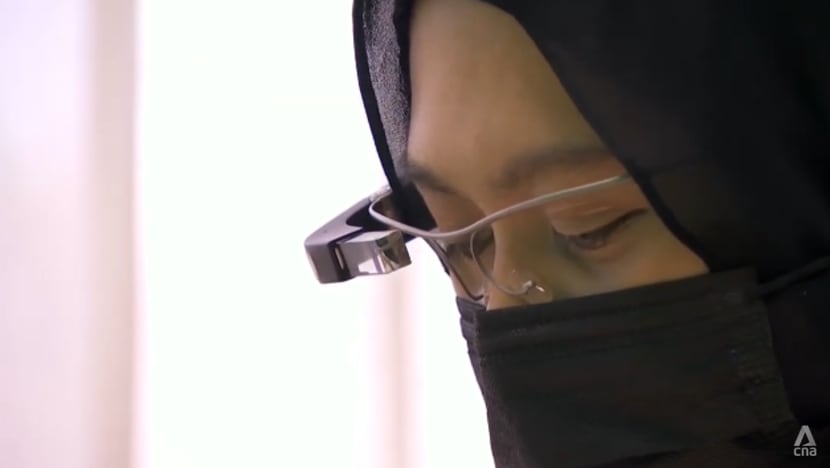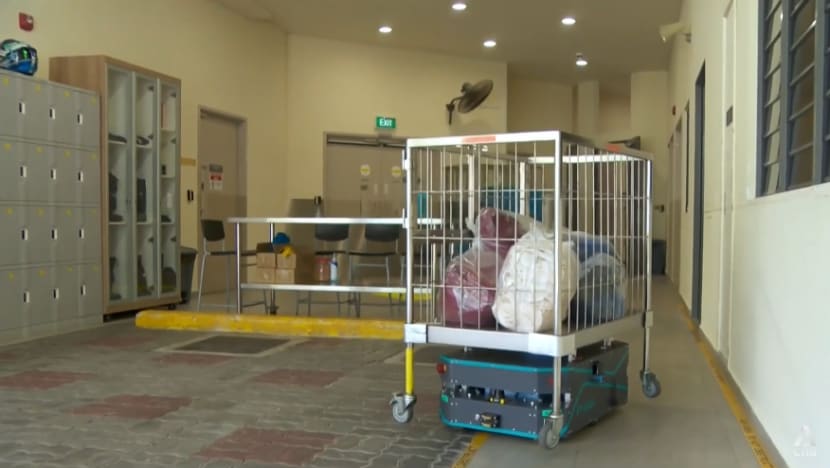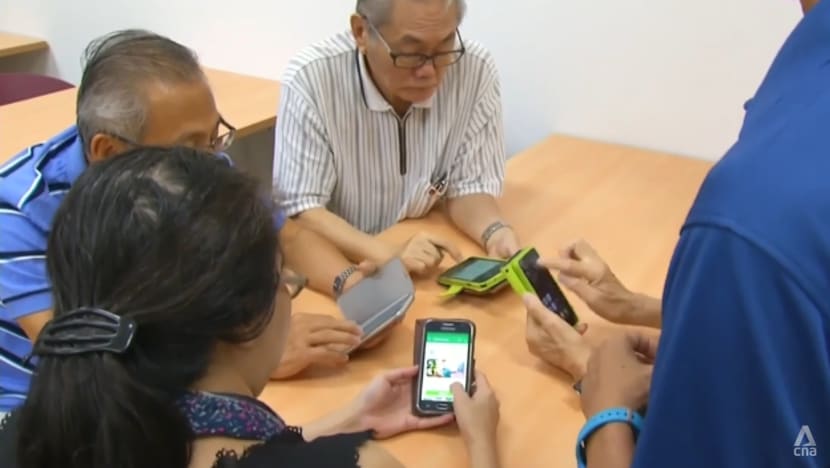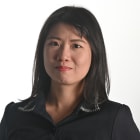Delivery robots and smart glasses: Innovations free up nursing home staff to provide better care
Industry observers said these technological innovations are saving caregivers’ time, and enabling nurses to provide better medical services to the elderly under their care.

A nurse uses smart glasses, which can capture and transmit what is seen in real time.
SINGAPORE: From robots that deliver bedsheets to smart glasses that allow nurses to transmit what they see, nursing homes in Singapore are investing in new technology.
NTUC Health, for instance, is using self-guiding robots to deliver linen and meals to wards in its nursing homes.
At its Chai Chee branch, the autonomous guided vehicle resembles a trolley and is capable of carrying loads of up to 180 kg, helping the home save more than 4,000 man-hours last year.
The system can independently move around the nursing home, using either a scheduled timing, or when activated by staff for deliveries.
Before the robot, nurses had to carry more than 70 bags of dirty and clean linen to over seven levels of wards each day. Aside from being time consuming, it was also physically demanding work.
MORE TIME FOR PATIENTS
Ms Samte Lunching, a senior nursing aide at the home, said that the time used for collecting linens can now be used to give more attention to the elderly under her care.
“With this system, we can give extra attention to our residents. It is really convenient and really saves our time and energy. I like that we have more time and we are less tired,” she said.
Mr Sim Tan Rui, NTUC Health’s senior manager of operations, said that amid a manpower crunch, the system helps relieve staff of some strenuous activities and low-value chores.
The home collaborated with Temasek Polytechnic in 2020 to develop the vehicle so that mundane tasks could be automated, freeing up employees for other jobs.
NTUC Health plans to equip all its nursing homes with the robot by next year.
What will it take to attract and retain good nurses in Singapore? Listen to Heart of the Matter:

SYSTEM FOR GEOFENCING
At the Ren Ci nursing home in Ang Mo Kio, a geofencing system has been put in place to easily locate seniors with dementia in the event that they get lost within the 10-storey building.
Residents tagged with the smart technology will trigger an alarm if they wander past certain perimeters in the vicinity, such as the exit, which will alert the security.
Previously, when a resident was missing, staff would have to comprehensively search each level of the home.
With the system, staff are now able to locate the residents much faster on a tablet that shows their location.
“When a resident with an RFID (radio-frequency identification) tag sewn into both their sleeves passes by the RFID reader, the system will trigger the alarm, which will notify the care staff and the security guard,” said the home’s senior care manager Tang Sze Chia.

SMART GLASSES FOR REAL-TIME TRANSMISSION
Ren Ci is also piloting the use of smart glasses for nurses, which can capture and transmit what they see in real time – essentially a video call, but hands-free.
When nurses visit the elderly at home, they sometimes have to provide medical services such as cleaning wounds.
At times, they need to consult more senior nurses for help by sending photos via messaging applications.
With the hands-free smart glasses, nurses are able to easily and immediately transmit what they see to a more experienced medical professional.
Nurses can then receive real-time advice on what to do.
INCREASING MARKET FOR HEALTH TECH
There are three key drivers fueling the deployment of technology for seniors, said Dr James Kah from the National University of Singapore’s (NUS) College of Design and Engineering.
They are: an ageing population, the increasing financial power of seniors and the rapid rise of new technology in the sector.
“We can expect to see newer technology emerge in the area of health monitoring, such as wearables,” he said. “Often, this goes hand-in-hand with digital health services like apps that seniors can use to look at their health status or for telemedicine consultation.”
Although most technologies made for seniors have to be imported from overseas, which can be expensive, industry observers said these innovations are saving caregivers’ time and enabling nurses to provide better medical services.
Dr Kah added that the number of local businesses that develop tech for the elderly is set to grow in this emerging silver economy.
“As people get trained and they get more aware of the challenges, and as the market size grows, we will definitely expect more companies to come in, look into all these areas of tech development, and to address the gaps in this silver economy,” he said.
He believes that gaps are already being bridged between seniors and technology, and implementation and usage will become increasingly seamless for both caregivers and their charges.
“Our next generation of seniors are more literate and have greater exposure to digitalisation. So, the barrier is reducing,” he said.
“Secondly, as we move into industry 5.0, there is also a greater emphasis in looking at the UI UX (user experience and user interface design) aspect of digital development, which will make the technology experience for seniors more comfortable.”
Some upcoming trends in elder-care technology include applications to address social isolation and depression, as well as tech that enables exercise, Dr Kah said.

















